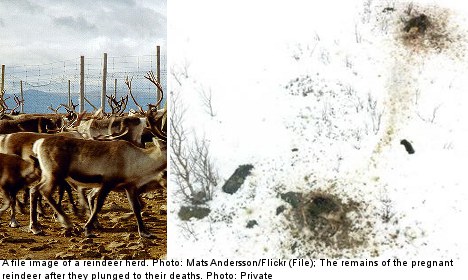“It’s just terrible,” Kjell-Åke Pittsa, chair of the Unna Tjerusj Sami village to which the herd belonged, told The Local.
“All of them jumped off the cliff and plunged to their deaths.”
The grisly discovery was made on Wednesday by a reindeer herder who traveled up in the mountainous region on the edge of the Stora Sjöfallet National Park following several days of harsh weather to check on the condition of the reindeer.
According to Pittsa, the reindeer were in the midst of calving when the tragedy occurred.
“They were all about to give birth,” he said.
Pittsa explained that there is only one plausible culprit for the mass reindeer death.
“They were hunted by a wolverine and were driven into a panic and had nowhere to go but over the cliff,” he said.
He theorized as well that a mixture of poor visibility and panic may have resulted in the frenzied reindeer failing to realize they were heading toward the cliff as they fled from the menacing wolverine.
While it remains unclear exactly how many reindeer perished in the incident, Pittsa estimated that around 30 animals died when they slammed into the ground below.
According to Pittsa, the precipice from which the reindeer leapt has an elevation of 1,200 metres, while the ledge onto which they crashed has an elevation of around 400 metres, meaning the reindeer flew about 800 metres to their deaths.
“They just exploded,” he said, adding that the hillside was also strewn with the remains of unborn reindeer.
“Every black dot you see in the pictures is a piece of reindeer.”
The incident has left Pittsa and other members of the Unna Tjerusj Sami village shaken.
“Nothing like this has ever happened to us before,” he said.
“When a predator gets a single reindeer, that’s something we can accept. But this is really tough.”
David Landes



 Please whitelist us to continue reading.
Please whitelist us to continue reading.
Member comments